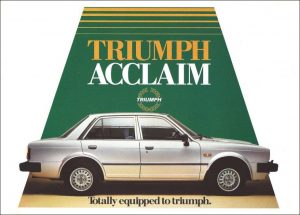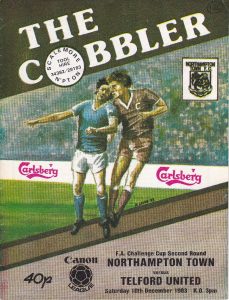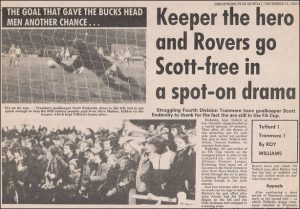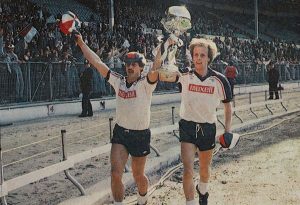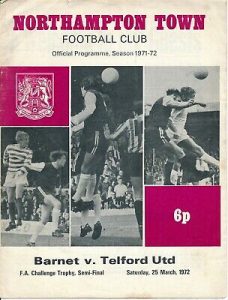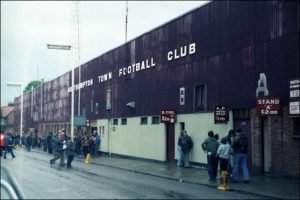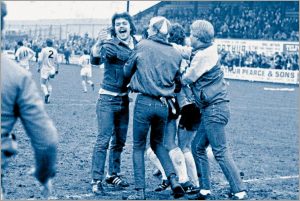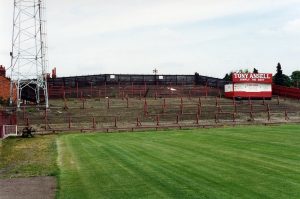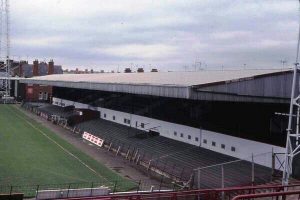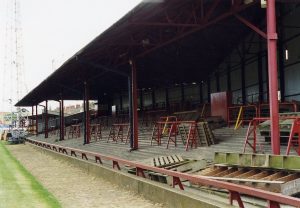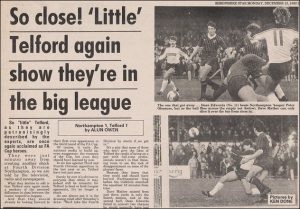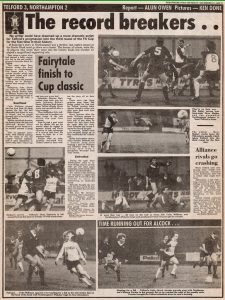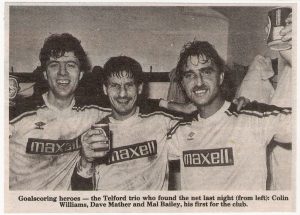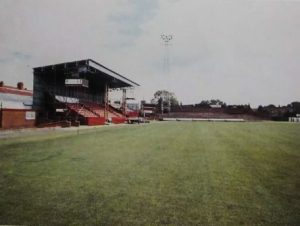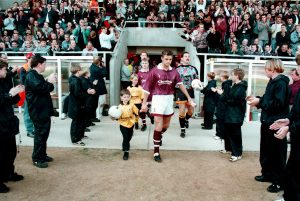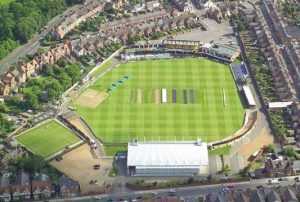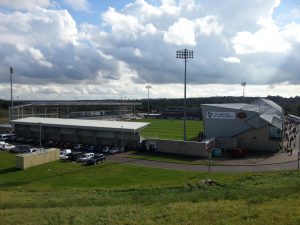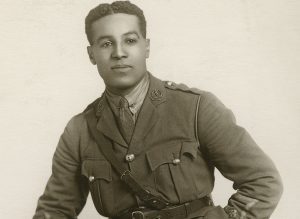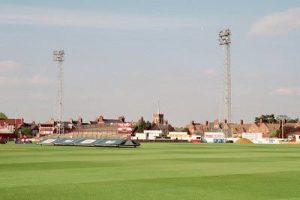Northampton Town 1 Telford United 1
FA Cup 2nd Round
10 December 1983
The context
Our big Cup-tie turned into one of those “my uncle’s thinking of going and I might be able to get you a lift” games. Somebody always had an uncle and he was usually annoyingly indecisive. This meant a nervous period of waiting on the morning of the match and a complicated sequence of phoning back and forth about possible start times and pick-up points, followed by – if you were lucky and the uncle in question decided he had nothing better to do – being squashed into the back seat of a Triumph Acclaim while the uncle and his mate went on about how the current players were nowhere near as good as Jack Bentley, George Jagger and Micky Fudge.
Telford had followed up their 1982 win over Wigan with a game at the Bucks Head against Fourth Division strugglers Tranmere. This generated national interest because of the very real chance cash-strapped Rovers would go out of business before the match could be played. In the event it was a combative affair – both on and off the pitch – in which visiting goalkeeper Scott Endersby proved irritatingly resilient. The Third Round draw gave us the prospect of a massive home game with neighbours Wolves. Tranmere however had other ideas, winning 2-1 in a brutal replay memorable for the dismissal of Telford’s commanding but psychotic midfielder Antone Joseph.
1982-83 ended with a strong finish in the league and a trip to Wembley where we overcame Northwich Victoria in the FA Trophy Final. The Lilywhites gained a reputation for staging dramatic fightbacks in key games, most notably in the semi-final against Harrow which saw them retrieve a 3-0 aggregate deficit by scoring five times in the away leg. The Trophy win gave a much-coveted exemption to the First Round of the following season’s Cup. This produced a home tie with Stockport from Division Four, and on another busy afternoon for the police Telford blitzed their visitors 3-0 in a performance so one-sided that the County players – among them a seriously riled Micky Quinn – resorted to wholesale fouling in an attempt to get the ball.
Our Second Round journey took us into unfamiliar territory. We usually avoided teams from the wrong side of Watford Gap because the early stages of FA competitions were drawn in Northern and Southern sections. But for some reason we were now on our way to what Midlands Today reminded us was the only three-sided ground in the Football League. Villa had won a tight game at the County Ground in the previous season’s Cup, with Match of the Day making much of its roped-off touchlines and other peculiarities. The Cobblers (how we laughed) also had my mate’s uncle and his pal coming over all nostalgic with memories of Ron Flowers, Graham Carr and the Trophy semi that Telford lost there in 1972.
The County Ground
Uncle’s confidence that he could negotiate the notorious M6/M1 route in a couple of hours had seemed hopelessly misplaced, so it was a pleasant surprise to be parking up on a side road off Abington Avenue a little before three. Uncle and friend strolled sedately while we trotted on ahead to ensure we made the kick-off. Our opportunity to observe the County Ground was limited but to be honest there didn’t seem very much to observe. It consisted of a single long maroon-painted facade onto the street and the same grubby red brickwork as many grounds of that era. The first turnstiles we saw had the usual barbed wire fence along the top, a straggly half-pissed queue of Telford latecomers, some grumpy coppers and a sign saying “visiting supporters only”. So in we went.
Telford had been blackballed at the Café Royal in 1981 so we harboured a grudge against the likes of Northampton. The re-election closed shop that existed in those days caused genuine resentment among supporters of progressive part-time clubs, to the extent that games against League sides were treated as opportunities to discredit a repressive system. A 500-strong following of Gola League Jack-the-Lads travelled in bullish mood – our arrogance was reinforced by the comprehensive hammering we’d given Stockport in the previous round, and as Northampton had taken two games to dispose of Waterlooville from the Southern League we didn’t feel they would give us too much trouble.
Despite this we weren’t about to start laughing at the facilities. Most small football grounds pre-Bradford were pretty crap, and as this one at least had decent terraces it was already better than most places we went. Northampton’s away end was a concreted hummock that extended just beyond the far post before ending abruptly in mid-air. Only a rickety fence prevented fans from falling off onto an adjacent bowling green (as it was a chilly afternoon no-one was playing bowls). There were some open-air toilets by the turnstiles and a bright-painted refreshment hut perched on the actual terrace, a garden shed-type oddity whose design owed nothing to the ornate cricket pavilion we could see to our left.
The cricket field of course was Northampton’s greatest novelty. Since Bramall Lane’s conversion in 1974 this had been the last football/cricket groundshare in the League, with Town famously obliged to play the opening and closing fixtures of each season away from home (an inconvenience deriving from their status as junior partners on the management committee). During summer the cricketers encroached onto a loop of the playing surface while the goalmouths were used for car parking, and in winter the outfield sprouted advertising hoardings and duckboards along the far touchline of the football pitch. The County Ground ballboys must have been fit. Today they were dressed in tracksuits several sizes too small and kept busy chasing vigorous hoofs into touch by two uncompromising defences.
On our right was rather a handsome stand. Despite dating from 1924 this appeared well-maintained (it had been re-roofed and re-seated in 1980 with the rear acquiring natty maroon sheeting). A long, narrow paddock in front held an eclectic mix of pipe-smokers, ankle-snappers and growlers. Denim- and bomber-jacketed types were gradually being supplanted around the segregation fences of Britain by younger, more casual stock characters – Northampton’s were putting on a sweater display, with the odd Fila tracksuit on show from those who felt the cold. The County Ground’s security seemed more aspirational than otherwise and pleasantries flew back and forth across a flimsy divide, along with the occasional coin and fist. The perimeter fencing had apparently been acquired from the nearest hardware store. Standing at the front was like watching football from inside a chip pan.
The terrace opposite looked much cosier than ours. This was the home fans’ beloved Hotel End. The hotel in question was the County Tavern, attached so intimately to the ground that the turnstiles opened into the pub yard. Northampton’s partisan support stood in a shabby 1940s enclosure with a gloomy overhanging roof seemingly held together by rust and moss. It had enjoyed its heyday in the Sixties, a seminal Cobblers decade during which the team was promoted three times, played a sensational 1965-66 season in the top flight and then returned just as swiftly to the lower reaches of the League. The County Ground’s capacity was severely tested in those years. Extra spectators were accommodated on makeshift wooden platforms along the cricket pitch side and the Kop gained additional steps propped up by a framework of struts.
The game
Telford looked comfortable from the start and proceeded to dominate the match. We went appropriately mental on 12 minutes when Dean Edwards managed somehow to scuff a Burrows back-pass into the Hotel End net, and Edwards and Dave Mather later missed chances they’d normally have buried. Had they done so it would have saved us a gruelling replay four days later, Kevin Lewis wouldn’t have been injured and a small squad might ultimately have had enough in the tank to inch past Derby in the Fourth Round. But the inevitable happened and journeyman striker Terry Austin equalised late on to send us back up the motorway slightly disappointed.
In all fairness the second game was a night to remember. Telford had eased into a 2-0 lead with goals from Mal Bailey and Colin Williams and up until the hour mark the proceedings seemed routine enough. Then, as so often used to happen, the professional team’s greater fitness started to tell. Maurice Muir and Billy Jeffrey scored in a fifteen minute spell and it looked as though we’d be headed back to the County Ground for another try. To add to the feeling of panic a dozen or so visiting lunatics kicked their way through a closed turnstile, sprinted across the away end and by some kind of hooligan osmosis rendezvoused with a mob of like-minded home fans for a bout of fisticuffs on the pitch in front of us.
But cometh the hour and all that. Our man was perennial favourite Mather and he rescued the occasion with a quarter of an hour to go, blasting a penalty (and very nearly visiting goalkeeper Peter Gleasure) into the net at the Buck’s Head End after John Alcock was poleaxed by Northampton bruiser Frankie Belfon. Cue bedlam, sundry pitch invasions, a bit more fighting and a much-belated final whistle from Colin Downey of Hounslow. A relieved crowd drifted off into the frosty night and I went home to enjoy what was left of my seventeenth birthday.
Sixfields
The Main Stand didn’t emerge from the Popplewell Report with very much credit. Its cladding might have been new but the supporting girders weren’t. They turned out to be dangerously corroded and in 1985 the whole roof had to come off. As Town lacked sufficient funds to build a replacement the entire seating tier was stripped back and covered over to protect the dressing-rooms and offices underneath, and a tiny stand erected on the paddock to accommodate directors and officials. This structure – known as the Meccano Stand – was initially sited towards the Kop but later moved to the half way line. The Kop itself saw an already limited capacity reduced still further when the rusting 1960s extension was also deemed unsafe. By 1990 the ground was effectively finished as a football venue.
The Cobblers were tenants and so improving the County Ground to comply with the Taylor Report wasn’t an option. A dangerous slump in form and a succession of last-day escapes from relegation made their financial situation even more precarious, and moving to a place of their own began to seem less a preference than a necessity. The solution was found a few miles away. Sixfields was a site on the outskirts of town where the council built a 7,800-seat ‘community stadium’ – funded by retail and housing development – on a reclaimed refuse tip. The opening game was on 15 October 1994 and Martin Aldridge scored the first goal in a 1-1 draw against Barnet.
Sixfields had many things the County Ground didn’t. It was nicely finished, there were four sides instead of three, everything was under cover and facilities for players and spectators, while basic, were clean and modern. But set against this was a heroic level of blandness. In an era notable for flat-pack stadia the Cobblers’ new home lowered the bar significantly. Back at the old place, meanwhile, the cricket club cracked on with removing any evidence that football was ever played there. Stands now cover much of the old playing surface and a monolithic office complex dominates the main frontage. Only the Hotel End turnstiles survive as part of the pub’s side wall. The forecourt where fans gathered before entering the terraces has become a storage area for beer barrels and disused garden furniture.
The new ground had a smart athletics club next door which gave the complex a purposeful, corporate appearance. But the runners had to leave in 2014 when work started on Sixfields’ new East Stand, and now the track is overgrown and derelict. This stand remains half-finished and (despite now having a roof and some wind-blown seats) shows little sign of ever being completed. What unity the stadium possessed has been destroyed. Its far side now has the appearance of a construction site, and half the refreshment facilities are blocked off behind wire fences and polythene sheeting. Visiting fans who want a drink have to cradle their plastic pints in a makeshift cattle pen outside the turnstiles.
Despite these minor inconveniences Sixfields is an enjoyable day out. Access routes are pretty good, the stewarding is low-key and you can park right outside and get off straight after the final whistle. If KFC, Subway and Frankie & Benny’s aren’t your bag then the pies are pretty tasty too. And there are some reasonable pubs nearby which all welcome football fans. The Walter Tull has a nice display of Cobblers memorabilia. It commemorates the pioneering black footballer who played for Town between 1911-14 and was killed serving with the Middlesex Regiment in World War One. The road leading to the ground is also named after him.
I have a theory that rubbish today is iconic tomorrow. No-one in the Seventies described Eastville as “quirky”, they simply moaned that dust blew in their faces on windy days and the smell of gas made them queasy. Such was the way with the County Ground and the same will be true here. As a Cobblers fan recalls, “One of the first games at Sixfields was delayed because there was a sinkhole in the pitch. Turns out it was a hole for rugby posts or something that had been covered over with a board and then turf and soil. I remember watching a couple of blokes digging about desperately trying to sort it out, thinking ‘This is a bit Mickey Mouse’.”
In these simple ways traditions endure.
Teams:
Northampton: Gleasure, Forster, Mundee, Gage (Muir), Lewis, Burrows, Jeffrey, O.Neill, Austin, Belfon, Hayes.
Telford: Charlton, Lewis, Turner, Joseph, Bailey, Eaton, Barnett, Williams, Mather (Alcock), Hogan, Edwards.
Attendance: 3903.
